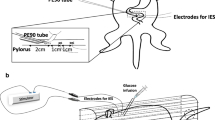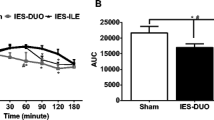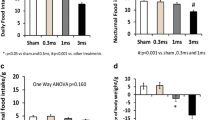Abstract
Background
Intestinal electrical stimulation (IES) has been shown to delay gastric emptying and reduce nutrient absorption in humans. The aim of this study was to investigate the effect of IES using an intraluminal method on postprandial blood glucose.
Methods
An oral glucose tolerance test with 150 g of glucose was performed in 10 healthy volunteers with and without IES (13 pulses/min, 300 ms and 5 mA). An intraluminal catheter with a pair of ring electrodes was incubated into the duodenum under endoscopy and used for IES. Gastric emptying was performed simultaneously using an established ultrasonic technique.
Results
(1) IES significantly decreased the postprandial glucose level from 15 min to 90 min after the glucose load. (2) The serum insulin level at 30 min but not other times after the meal was lower in the IES session than that in the control session (p = 0.06). (3) The half-time of gastric emptying with IES was increased from 27 ± 4.8 min in the control session to 36 ± 8.5 min with IES (p < 0.01). (4) The symptoms score of dyspepsia were almost the same between the two sessions except that IES induced a slightly higher nausea symptom score.
Conclusions
IES decreases postprandial blood glucose possibly by delaying gastric emptying and other unknown mechanisms and the intraluminal method of IES may serve as an excellent screening and research tool for various applications of IES. Further clinical studies are needed to explore therapeutic potentials of IES for diabetes.





Similar content being viewed by others
References
US Centers for Disease Control. (2007). Available from: http://www.Cdc.gov/diabetes/pubs/pdf/ndfs_2007.pdf.
Herman WH. Diabetes epidemiology: guiding clinical and public health practice. Diab Care. 2007;30(7):1912–9.
Ceriello A. The emerging role of post-prandial hyperglycaemic spikes in the pathogenesis of diabetes complications. Diabet Med. 1998;15:188–93.
Yin JY, Ouyang H, Chen JDZ. The effects of duodenal electrical stimulation (DES) on food intake, gastric tone and gastric myoelectrical activity on dogs [abstract]. Neurogastroenterol Motil. 2002;14:456.
Reister SB, Schusdziarra V, Bollschweiler E, et al. Effect of enteric pacing on intestinal motility and hormone secretion in dogs with short bowel. Gastroenterology. 1991;101:100–6.
Kelly KA, Code CF. Duodenal-gastric reflux and slowed gastric emptying by electrical pacing of the canine duodenal pacesetter potential. Gastroenterology. 1977;72:429–33.
Liu S, Hou X, Chen JDZ. Therapeutic cpotential of duodenal electrical stimulation for obesity: acute effects on gastric emptying and water intake. Am J Gastroenterol. 2005;100:792–6.
Zhao XT, Wang LJ, Xu XH, et al. Electric stimulation of small intestine delays gastric emptying in the dog model [abstract]. Neurogastroenterol Motil. 2002;14:457.
Chen JD, Lin HC. Electrical pacing accelerates intestinal transit slowed by fat-induced ileal brake. Dig Dis Sci. 2003;48:251–6.
Sun Y, Chen JDZ. Intestinal electric stimulation decreases fat absorption in rats: therapeutic potential for obesity. Obes Res. 2004;12:1235–42.
Liu J, Qiao X, Hou X, et al. Effect of intestinal pacing on small bowel transit and nutrient absorption in healthy volunteers. Obes Surg. 2009;19:196–201.
Spahn TW, Wessels A, Grosse-Thie W, et al. Assessment of pre-gastroscopy fasting period using ultrasonography. Dig Dis Sci. 2009;54(3):621–6.
Yang G, Wang L, Wang D. Glycometabolism and function of pancreatic cell in type II diabetes patients. Chin J Public Health. 2009;25(4):404–5.
Lin X, Peters LJ, Hayes J, et al. Entrainment of segmental small intestinal slow waves with electrical stimulation in dogs. Dig Dis Sci. 2000;45:652–6.
Klein R. Hyperglycemia and microvascular and macrovascular disease in diabetes. Diab Care. 1995;18:258–68.
Pirart J. Diabetes mellitus and its degenerative complications: a prospective study of 4,400 patients observed between 1947 and 1973 (part 1). Diab Care. 1978;1:168–88.
Lehto S, Ronnemaa T, Pyorala K, et al. Predictors of stroke in middle-aged patients with non-insulin-dependent diabetes. Stroke. 1996;27:63–8.
Groeneveld Y, Petri H, Hermans J, et al. Relationship between blood glucose level and mortality in type2 diabetes mellitus: a systematic review. Diabet Med. 1999;116:2–13.
Horowitz M, Edelbroek MA, Wishart JM, et al. Relationship between oral glucose tolerance and gastric emptying in normal healthy subjects. Diabetologia. 1993;36:857–62.
Jones KL, Horowitz M, Carney BI, et al. Gastric emptying in early noninsulin-dependent diabetes mellitus. J Nucl Med. 1996;37:1643–8.
Thompson RG, Pearson L, Schoenfeld SL, et al. Pramlintide, a synthetic analog of human amylin, improves the metabolic profile of patients with type 2 diabetes using insulin. The Pramlintide in type 2 diabetes group. Diab Care. 1998;21:987–93.
Singh-Franco D, Robles G, Gazze D. Pramlintide acetate injection for the treatment of type 1 and type 2 diabetes mellitus. Clin Ther. 2007;29:535–62.
Nauck MA, Niedereichholz U, Ettler R, et al. Glucagon-like peptide 1 inhibition of gastric emptying outweighs its insulinotropic effects in healthy humans. Am J Physiol. 1997;273:E981–8.
Gonlachanvit S, Hsu CW, Boden GH, et al. Effect of altering gastric emptying on postprandial plasma glucose concentrations following a physiologic meal in type-II diabetic patients. Dig Dis Sci. 2003;48(3):488–97.
Schwartz A, Kajekar R, Ort T, Wade PR, Hornby PJ. Electrical stimulation of isolated rat intestine in the presence of nutrient enhances glucagon-like peptide-1 release. Digestive Disease Week, New Orleans, LA, Abstract #W1366, May 2010.
Yin J, Chen JDZ. Mechanisms and potential applications of intestinal electrical stimulation. Dig Dis Sci. 2010;55:1208–20.
Yin J, Zhang J, Chen JD. Inhibitory effects of intestinal electrical stimulation on food intake, weight loss and gastric emptying in rats. Am J Physiol Regul Integr Comp Physiol. 2007;293:R78–82.
Disclosures
No financial support was received from outside sources for the study.
Contributions
Jinsong Liu performed the research, analyzed the data, and wrote the paper. Yifei Xiang performed the research and measured the gastric emptying. Xian Qiao measured the blood glucose. Yu Dai performed the plasma insulin detection. Jiande Chen designed the research study, analyzed, the data and wrote the paper.
Competing Interests
The authors have no competing interests.
Author information
Authors and Affiliations
Corresponding author
Rights and permissions
About this article
Cite this article
Liu, J., Xiang, Y., Qiao, X. et al. Hypoglycemic Effects of Intraluminal Intestinal Electrical Stimulation in Healthy Volunteers. OBES SURG 21, 224–230 (2011). https://doi.org/10.1007/s11695-010-0326-5
Published:
Issue Date:
DOI: https://doi.org/10.1007/s11695-010-0326-5




